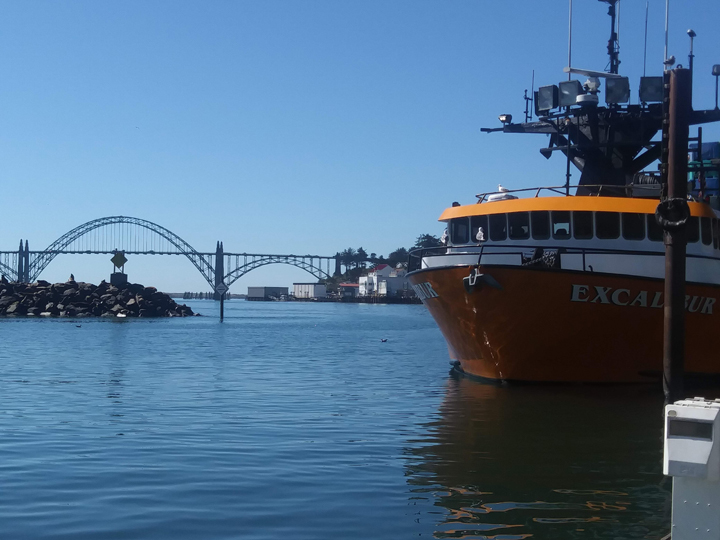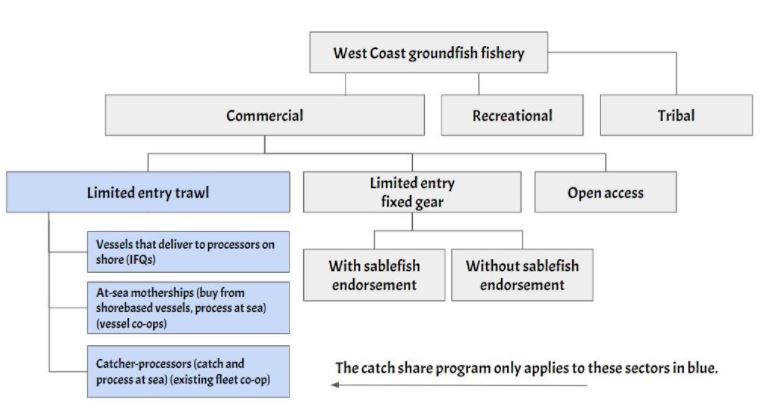
The Council has created two catch share programs in the limited entry nontribal commercial groundfish fishery: a fixed gear sablefish program implemented in 2002, and a trawl catch share program implemented in 2011. This fact sheet focuses on the trawl catch share program.
The trawl fishery makes up a large proportion of the groundfish fishery, which is typically the second most valuable commercial fishery on the West Coast, after Dungeness crab. In some years, the value of the commercial groundfish fishery exceeds the crab fishery.
This program revolutionized the way the Council manages groundfish allocated to the trawl sector. Before catch shares, fishery managers and participants were concerned about too many vessels chasing too few fish, as well as competition between trawl sectors.
In 2000, the Federal government declared the groundfish fishery a disaster. Several species were overfished, and the Council was using trip limits to manage the fishery for most species other than whiting. (Trip limits set the amount of fish allowed to be landed in a given two-month period). At the same time, the Magnuson-Stevens Fishery Conservation and Management Act had recently been reauthorized, placing strict limits and requirements around overfished species. In response, the Council reduced trip limits and closed large areas of the continental shelf to fishing.
The restrictive trip limits had a negative consequence: they forced vessels to dump excess fish overboard, mostly dead. This was a wasteful and widely unpopular practice that needed to be changed. At the same time, shorter and shorter seasons were making the whiting fisheries inflexible and inefficient.
The restrictions and closures to protect overfished species were very hard on the fleet and the communities that depended on a healthy fishing industry. Because the trawl fleet lands such a large amount of fish throughout the year, its health is critical to maintaining the fishing infrastructure (ice machines, hoists, processors) needed by other fisheries, including salmon, crab, shrimp, and others.
In 2003, a Federal buyout of trawl permits removed almost half of the historically used capacity of the trawl fleet and allowed some trip limits to be increased. Although this helped, it did not solve the problem. Around that time, the Council began formal discussions about creating a trawl catch share program.
The Council designed its catch share program to balance the needs of the fishery with those of communities, new fishery entrants, and small boat fishermen. The goals included increasing individual accountability, reducing bycatch, and improving economic efficiency, among others.
The trawl catch share program was put in place in 2011 after eight years of discussion and dozens of public meetings. The Council continues to periodically review performance of the program and make adjustments to improve it.
How the program was developed
The catch share required two major policy developments: design of the catch share system itself, and allocation of fish between the trawl and other sectors (see diagram).
Allocation of catch opportunity among sectors
For a catch share program to work, managers must specify the amounts of fish that will be allocated to each sector. Within the limited entry trawl sector there are three subsectors, each of which has their own catch share system for which allocations are needed: vessels that deliver to processors on shore (“the shorebased sector”); at-sea motherships (which buy catch from shorebased vessels and process fish at sea); and catcher-processors (which both catch and process fish (mostly whiting) at sea. The allocations for these subsectors are based on formulas set in Amendment 21 to the fishery management plan, or are determined during the biennial management process.

Some species are caught infrequently by the trawl sector and are not managed as part of the catch share program. Certain amounts of these species are set aside from allocations, and catch is monitored to ensure that it stays within those set-asides, and to ensure that the entire groundfish fishery is within annual catch limits.
Catch share program design
Initial allocation of quota
Shorebased: For the shorebased limited entry trawl sector, quota shares were allotted based on catch history and other factors. In addition, shorebased processors received 20 percent of the shorebased sector’s whiting quota shares.
Mothership: In this sector, trawlers were allotted quota shares as what is called “catch history.” Those allocations were based on their permit’s history in the fishery. Catch history is different from quota shares in that it is allocated in non-divisible blocks.
Catcher-Processors: In 1994, a license limitation program resulted in catcher processors buying permits from smaller vessels and combining them into ten larger permits. In 1997, whiting was allocated based on sector, and these ten permits joined together to form a co-op.
Limits on catch shares
One of the main goals of the catch share program was to make the fishery more efficient, which was expected to lead to fleet consolidation. The Council recognized that too much consolidation could harm communities and crew, so they placed limits on quota shares.
For shorebased fisheries, the Council limited the amount of individual fishing quota (IFQ) shares an individual could control at any one time and the amount of quota pounds a vessel could fish annually.
For the mothership sector, limits were placed on the amount of catch history any entity could own, the amount a vessel could catch, and the amount any single mothership processor could process.
Allocations to the catcher-processor sector go to the entire sector. Although there are accumulation limits for this sector, they only go into effect if the owners of catcher-processor-endorsed permits fail to form a single co-op.
The Council also designed an “adaptive management” program that puts quota aside in a “public trust pool” in case it is needed to address problems caused by the program. For example, these shares can be used to support community and processor stability, conservation, new entry, or to compensate for unintended consequences. This program has not yet been used.
How it works
Shorebased sector
As described above, quota shares were issued at the start of the program. These quota shares can be transferred among participants and to new entrants, including crew members, communities, processors, or any other entity eligible to own a U.S fishing vessel. Each year, quota share owners receive an allocation of quota pounds that vessels must use to cover their catch.
Each vessel is responsible to the government for its own compliance with the catch share program. Vessels are responsible for buying or leasing the quota pounds in order to cover their harvest. Shorebased vessels generally harvest a mix of species, though for whiting trips the incidental catch of other species is low. Their ability to harvest all of their individual quota holdings, and the trawl allocations as a whole, depend on their ability to control the mix of species in their catch. Some species are always likely to be in shorter supply and to limit overall harvest. If a vessel’s harvest exceeds its quota pound holdings, the vessel may not continue to fish until it has acquired quota pounds to cover its deficit. Vessels with trawl permits are also allowed to use non-trawl gears to catch their trawl quota pounds (known as gear switching).
The quota share program has reduced the unintended catch of overfished species. Quota pounds for overfished species have been more expensive than for other species, because the allowed harvest is low and fewer quota pounds are issued. This creates an incentive to avoid hotspots for these species and to develop gear to avoid them. Those who can avoid overfished species fare better economically, as they can land the rest of their quota without being shut down. If they can avoid catching overfished species, they can also generate revenue by leasing their unneeded overfished species quota to others.
Mothership sector
When the owners of a catcher vessel permit endorsed for delivery to motherships joins a mothership co-op then the allocation associated with that permit (its “catch history”) is assigned to that co-op as its annual allocation. If a mothership catcher vessel chooses not to join a co-op, then its allocation is assigned to an open fishery in which all such vessels compete. Vessels which join a co-op are responsible to the co-op for their catch. In turn, the co-op is responsible to the government for complying with its allocation. While only catcher vessels with mothership catcher vessel permits have catch history assignments, any trawl permitted vessel is eligible to fish for a co-op. So far, every mothership endorsed catcher vessel with a mothership endorsed permit has decided to join a co-op and they have only formed one co-op (i.e. all vessels have joined the same co-op).
While shorebased QS can be transferred to any person eligible to own a US documented fishing vessel, mothership sector catch history can only be transferred between limited entry mothership catcher vessel endorsed permits.
Catcher-processor co-ops
Each year, sector participants join to form a single co-op, which manages the sector’s entire allocation of whiting. If at some time in the future the sector fails to form a single co-op, the system will convert to an IFQ program and quota shares will be allocated equally among all catcher-processor permits.
Trailing action policies
When the program was put in place, many old trawl regulations remained that were no longer needed. The Council changed and removed many of these outdated regulations–for example, extending the shoreside whiting season, eliminating restrictive gear regulations, allowing vessels to carry multiple trawl gear types at the same time, and largely eliminating the trawl shelf area closure used to limit impacts on overfished species. (See the Amendment 20 page for more details).
Program Reviews
As required by the MSA, the Council periodically reviews the performance of the program. For information on the effects of the program, see the five-year catch review finalized in 2017. The next program review is scheduled to begin in 2022.
For more information, please contact Council Staff Officer Jim Seger.